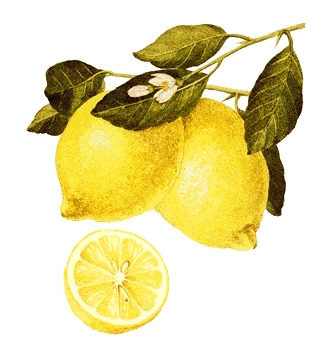Lemon is a small, oval, yellow citrus fruit. People in many parts of the world enjoy lemon-flavored foods and lemon-flavored beverages. Lemons have a pleasing scent, and most varieties have a tart taste. Lemons are rich in vitamin C.

The lemon is a type of berry called a hesperidium. The most common varieties measure about 3 inches (7.6 centimeters) in length and about 2 inches (5 centimeters) in diameter. Lemons have a nipplelike bulge at one end. The interior of the fruit consists of 8 to 10 segments, which contain the pulp, juice, and seeds. The leathery yellow outer rind has many tiny glands that contain fragrant oils.
People rarely eat fresh lemons because of the fruit’s sour taste. However, lemon juice and oil are used in a wide variety of food products. For example, lemonade, several soft drinks, and many other beverages are made with lemon juice. Such foods as candy, cakes, cookies, and salads, as well as various fish and meat dishes, are flavored with lemon juice and oil. Lemon oil is also used as a scent in various nonfood items, such as household cleaning products, soap, and shampoo, perfume, and other cosmetics.
Lemon growers worldwide cultivate millions of tons of lemons annually. The leading lemon-producing countries include Argentina, Brazil, China, India, and Mexico. Lemons are either sold as fresh fruit or processed into juice and oil.
Growing lemons.
Lemon trees can reach a height of 22 to 25 feet (6.7 to 7.6 meters). They are thorny and have long, pointed, pale green leaves. The trees produce purple-tinged white, fragrant flowers. Lemons develop from the ovaries of the blossoms and ripen about seven to eight months after the flowers bloom. Lemon trees often have blossoms and fruit at the same time.
Lemon trees are grown from buds cut from trees that produce the type of lemon desired. The buds are grafted to seedling lemon trees called rootstocks (see Grafting (Other kinds of grafting)). Rootstock varieties are chosen for their resistance to disease and for various other reasons. Lemon trees start to produce fruit about 2 years after grafting, and some continue to bear fruit for 50 years.
Lemon trees may be severely damaged by frost and freezing temperatures, and growers use many methods to protect the trees from cold weather. For example, some growers prevent frost by warming the cold air near the ground with oil-burning heaters. Other growers use large fans called wind machines to mix the cold surface air with the warmer air above it. Water sprays under the trees also help protect against cold.
Lemon trees may also be attacked by such pests as mites, scale insects, and thrips. Mites and scale insects feed on the leaves, fruit, and twigs of the trees. Thrips attack the buds and the fruit. Growers combat such attacks by growing varieties of trees that resist pests and by spraying the trees with insecticides. They also spray orchards with fungicides to fight fungal diseases, which attack the leaves, fruit, and roots of the trees.
Harvesting and processing.
Lemon trees bear fruit throughout the year, and growers harvest the fruit 2 to 10 times a year. The largest harvests occur in the autumn and winter. However, lemons are commonly stored for several months for sale in the spring and summer.
Lemons to be sold as fresh fruit are picked before they reach full size and maturity. Then they are stored under special conditions so that they are less likely to be damaged during shipment and are more attractive than those shipped immediately after harvest. Decay can be a problem during the marketing of fresh lemons. Blemished lemons and lemons that are too mature at harvest are sent directly to factories for processing.
History.
Lemons probably originated in northeastern India, near the Himalaya. Lemons were taken from India to Italy by the Arabs in the A.D. 100’s, and to Spain in the 1100’s. In 1493, the Italian navigator Christopher Columbus planted the first lemon trees in America. By the late 1700’s, Spanish missionaries had taken lemon trees to California. The first commercial lemon orchards in the United States were planted in the late 1800’s.
